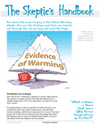|
|
Another day is The Backdown? Everything is more important than carbon action these days. In China, real pollution is trumping the fake kind. China has been toying with carbon markets, but this month announced they might have to back away. (The shame!)
[Reuters] “…the all-out efforts to combat China’s disastrous pollution levels might get in the way of plans to tax carbon dioxide emissions in a bid to stunt the rapid growth of greenhouse gas emissions, Zhu Guangyao, the vice environment minister, said.
“We have to reflect the requests of the majority through many consultation rounds,” he told the Beijing Morning Post from the sidelines of China’s annual parliamentary sessions.
A carbon tax is increasingly controversial among lawmakers, said Zhu, adding that an environment tax would be easier to push through without carbon in the mix.
Zhu also referred to the fact that Australia, under a new conservative government, is trying to abolish its carbon tax, while a price on carbon has been blocked in the United States.”
China’s carbon markets were never serious anyway — the glorious plan was to launch seven pilot trading schemes — and each new market was an excuse for environmental activists to issue press […]
Here’s a graph showing something about Australian, Chinese and Indian emissions (thanks to Tom Quirk). At a glance you might think we are up there with the best of them (doing our bit to fertilize the flora of the planet, and to regreen the deserts). Alas, the Australian tally (the green triangles) represents the total emissions of Australia. The lines depicting Chinese and Indian emissions just show their annual increases.
Chinese annual increases in emissions are larger than the entire Australian output. India is not too far behind.
UPDATE: TonyfromOz points out the Y-axis scale is missing three zero’s. Data source: CDIAC (Thanks Anton).
It appears the new coal fired power stations and cars coming on line in the breakneck-evolution-of-China produced twice the emissions of the entire continent of Australia.
Remember our aim to reduce our national output by 5% or so by 2020. Thanks to the Renewable Energy Target, the Clean Energy Fund, the Remote Indigenous Energy Program, the Low Income Energy Efficiency Program, the Living Greener program, the Regional Natural Resource Management Planning, the Light Vehicle CO2 Emissions Standards, the Household Assistance Package, and not to mention another 36 programs I could have listed as […]
Rudd has a chance to dump a dumb policy, but won’t
Australia’s overpriced, unneccessary carbon tax will become even more overpriced next Monday (from $23 to $24.15 per ton). A spokesman tells The Australian that the all-new Labor cabinet will reconsider it all next week and may bring in the trading scheme sooner rather than later. At the moment the Gillard-fixed-carbon-price will shift to a floating price (lately, a sinking price) in two years time in mid 2015. The current EU price is $6 AUD.
The Australian understands Mr Rudd will look at all aspects of the implementation of the $23 a tonne price on carbon as a priority. The reinstated Prime Minister sought to cement his commitment to tackling climate change, declaring he had “long been committed to a carbon price”.
Rudd mistakes token efforts in China for “action”:
He accused the Coalition of inconsistency on the issue and cited action in China as evidence “carbon pricing is now becoming more and more of a global reality”.
The real global reality and action in China is that it is building more coal powered stations than anywhere, and is one of the largest coal burning nations in the world. China […]
Guest post by Anton Lang (TonyfromOz)
(Thanks to ianl8888 for bringing this map from Tallbloke’s site to my attention)
This is a map of projected coal fired power plants that have been approved for construction. The map tells us a lot about the Kyoto Protocol, and more specifically, just how much clout does the UN really have.
Some parts of the world are increasing their coal fired electricity faster than others (Click to enlarge).
Source: Figures come from this World Resources Institute Report. (Nov 2012) Graphic? author unknown.
Kyoto was adopted in 1997, and so far, 195 Member Countries have signed up to it with that first signature. All but a couple of countries then added that all important second signature ratifying it, meaning that they were bound by what Kyoto asked for, a reduction of CO2 emissions to a level 5% lower than what they were in 1990. In 2007, Rudd added that second signature on behalf of Australia, leaving the U.S. as the only country not to ratify the Protocol. Some countries have said that they will not ratify any rehash of Kyoto, which expired at the end of last year. Only 24 […]
Who isn’t finding shale gas these days? To whom shall we sell all those super-costly solar units, that we will supposedly be “world leaders” in? China reveals 25tn cu metres of shale gas Financial Times
China announced the results of its most extensive official appraisal of shale gas reserves on Thursday, having found potentially recoverable resources of 25.1tn cubic metres – less than previous estimates.
Although the figure is lower than an earlier estimate of 31tn cubic metres, China is still believed to have some of the largest reserves of shale gas in the world and has been working to develop shale gas as a cornerstone of its energy policy. The new estimate is enough gas to meet the country’s current consumption for nearly 200 years if fully extracted.
As Richard North points out, this changes everything:
8.6 out of 10 based on 58 ratings […]
A blockbuster Chinese study of Tibetan tree rings by Liu et al 2011 shows, with detail, that the modern era is a dog-standard normal climate when compared to the last 2,500 years. The temperature, the rate of change — it’s all been seen before. Nothing about the current period is “abnormal”, indeed the current warming period in Tibet can be produced through calculation of cycles. Liu et al do a Fourier analysis on the underlying cycles and do brave predictions as well.
In Tibet, it was about the same temperature on at least four occasions — back in late Roman times (those chariots!), then again in the dark ages (blame the collapse of industry), then in the middle ages (the Vikings?), then in modern times (blame the rise of industry).
Clearly, these climate cycles have nothing to with human civilization. Their team finds natural cycles of many different lengths are at work: 2-3 years, 100 years, 199 years, 800 years, and 1,324 years. The cold periods are associated with sunspot cycles. What we are not used to seeing are brave scientists willing to publish exact predictions of future temperatures for 100 years that include rises and falls. Apparently, it will […]
Gallup has done a world wide poll, about whether people believe the theory of man-made global warming. Though don’t stake too much money on the results, they only interviewed “approximately 1000 people” (what’s an approximate person?).
*So we’re talking about a survey of about 10 people per country.
The headlines are outrageously ambitious , “most of the human race”, yet having surveyed 111 countries it’s sort of half-way believable (with caveats). What’s striking is that the great man-made global warming theory has left no corner of the globe untouched… 10% of Somaliland believes it fergoodnesssake. (Well OK, so one person said “yes”.)
But it begs a few questions — like how do you phone poll accurately in countries where there are not many phones, and hardly anyone speaks English?
The China statistic is interesting. For all the talk that the world’s largest emitter of CO2 is “speeding to take up renewable energy” it ranks 105th out of 111 countries. “79%” of Chinese people are skeptics (well, more or less).
7.8 out of 10 based on 4 ratings […]
Greg Combet (our Minister for keeping-the-weather-the-same) can keep a straight face when he tells coal miners that their jobs are protected with him. You might think that’s insane, (especially if you are Green) but he has a point. Even if carbon mattered, our coal exports do not. (Not that Combet seems to explain this point very well, he seems to think people won’t notice the contradiction about supposedly “making the big polluters pay”, even though he’s taxing mom-and-dad and partly-exempting Big-Coal).
Australia is the worlds largest exporter of coal, you’d think our production mattered. But Combet knows that it makes no difference at all to the environment if we dig masses of coal up and send it to the Chinese to burn. Australia might have lots of coal, but it earned the ‘biggest exporter” title only because lots of the other contenders forfeited. Basically, we only win because there are not many people living here. Other places dig up a lot more coal, but coal is so handy, vital, and irreplaceable that they keep every last sodding bit, burn it all themselves and have none left over to sell.
Australia sold about $55 billion dollars worth of coal in 08/09, […]
Tomb of Hong Quan Fu. Photo Iflwlou拍攝
It seems a warmer climate might be bad, but a colder one is deadly.
Once upon a time, people thought that overpopulation triggered crashes, but in this study by Lee and Zhang the hard numbers suggest instead that it was climate, and of course, it’s not the warmer kind of climate that causes the problems but the colder kind.
Malthusian cycles of population boom and bust aren’t the drivers here (though presumably having a large population means there is little buffer when the deadly cold spells hit).
From NIPCC: Cold Periods caused population crashes in China over the last millenium
…there were 5 major population contractions in China between 1000 CE and 1911, and all of them occurred in periods with a cold climate, when mortality crises triggered population collapses. [Abstract]
How much fun can you have in a long frost? Almost every kind of uprising, pain or plague.
In one population crash, the losses were as high as 49% of the peak. In the face of a 50:50 death rate, “perspective” doesn’t seem like quite the right word.
10 out of 10 based on 2 ratings […]
The public might not understand the science, but they do understand cheating
Dr. David Evans 6 October 2010
[A series of articles reviewing the western climate establishment and the media. The first and second discussed air temperatures, the third was on ocean temperatures, and fourth discussed past temperatures, the fifth compared the alleged cause (human CO2 emissions) with the alleged effect (temperatures) and the sixth canvassed the infamous attempt to “fix” that disconnect, the hockey stick.]
Click to download a pdf file containing the whole series
The western climate establishment consists of the climate science research bodies in the western world, and their climate scientists. The leading organizations are the IPCC of the United Nations, the CRU in Britain, and GISS and NOAA in the United States. Personnel move around within the establishment, getting funding from the same sources, collaborating on projects, and publishing in the same journals.
There are other climate establishments in this world, and […]
A sample of recent scientific news from NIPCC * The Glaciers of Greenland were smaller 5000 years ago; * African savanna trees thrive with increases in CO2; * It was hotter in China a thousand years ago, and by a whole degree; * Marine-life-with-shells can’t agree on their favourite CO2 level and * Temperatures make no difference to the 5000 year record of hurricanes. […]
Thanks to Down To Earth Magazine. Author: DIVYA
All round the world thousands of greenonomists recommend a “free market solution” to our so called pollution problem. But as I keep saying: this “free market” isn’t free. It’s a pale pathetic imitation: a “managed market”.
In Europe, if a factory produces CO2 (what factory doesn’t?) it can pay people in China and India to not produce an-equivalent-amount-of-CO2. Sounds sort of fine in intent except that paying people to not do something they were-going-to-do depends on knowing the future (and reminds us of a process known as extortion). That’s loophole number one. Officially it’s called “additionality”, which is a fancy way of saying people wouldn’t do something-in-particular to reduce emissions unless they got paid in carbon credits.
The Chinese and Indians, not being stupid, immediately gamed the system. Why wouldn’t they?
The irony of unintended consequences. Here’s how it goes: HFC-23 is the godfather of greenhouse gases: it’s 11,700 times as powerful at warming as CO2 is. The chemical makers are paid as much as $100,000 in carbon credits for every ton they destroy… Suddenly making-and-then-destroying HFC-23 is very valuable business, so people rush to fill this “demand”. HFC-23 is a […]
|
JoNova A science presenter, writer, speaker & former TV host; author of The Skeptic's Handbook (over 200,000 copies distributed & available in 15 languages).

Jo appreciates your support to help her keep doing what she does. This blog is funded by donations. Thanks!


 Follow Jo's Tweets
Follow Jo's Tweets To report "lost" comments or defamatory and offensive remarks, email the moderators at: support.jonova AT proton.me
Statistics
The nerds have the numbers on precious metals investments on the ASX
|












Recent Comments